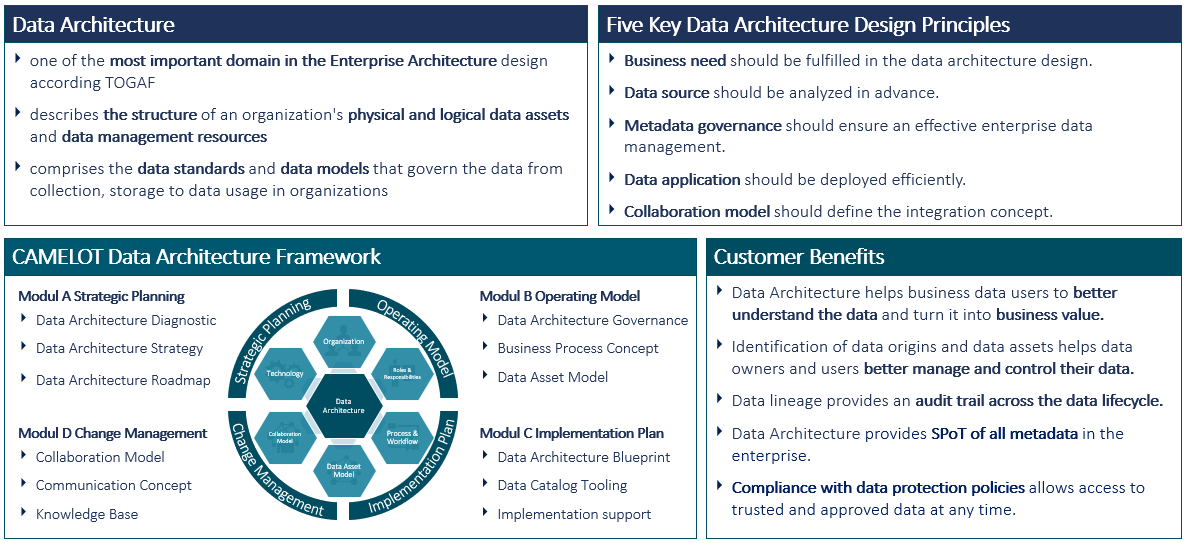Working with large quantities of data not only opens up new opportunities for organizations but also creates new risks. For example, organizations can lose track in too much data. Data architecture, understood as organizational competence, addresses this Big Data challenges and enables the strategic management of data as an asset.
Data Architecture Creates Clarity in Data Chaos
The global volume of data is exploding in all areas of society. From around 33 zettabytes in 2018, it is expected to increase by around 27 percent annually to 175 zettabytes by 2025 (equivalent to 175 billion terabytes). Within companies and organizations, the effects of these developments are already being felt. For example, employees spend around 30 percent of their time searching for data and information – and the trend is rising. Digital transformation projects are stalling, not because of a lack of data causing impediments. Instead, it is the diversity and volume of data that is creating unexpected organizational and technological challenges. For example, while data seems to be the new oil, many organizations are struggling to harness and commercialize it. Worse still, many organizations are increasingly losing track of their data assets, which in turn inhibits digitalization approaches and potential for further development, ultimately jeopardizing their overall competitiveness.
For these reasons, in organizations overwhelmed with information and data, clarity is a value in itself: Clarity that must be created organizationally, technologically, and culturally in organizations of all kinds – from commercial enterprises to public administration – in order to be competitive in the 21st century. Clarity that must be ingrained and cultivated sustainably in organizations, as it might get lost otherwise. Clarity that shifts the view on data, so they are not seen as a by-product or waste product of an organization, but as an asset to be managed in a similar way to personnel or infrastructure.
Data Architecture: Concept for Organizational Competence
Data architecture, understood as organizational competence, creates just such clarity. It needs to be built up in order to tackle the challenges of Big Data and digitalization.
What is Data Architecture?
Data architecture is a specific sub-architecture of enterprise architecture. Its aim is to support organizational value creation and strategic development through the quality-assured, user-oriented, and timely provision of information about data as an asset. The main functions of this organizational competence are the identification, description and future-oriented modeling of data and data relationships.
Descriptive and Prescriptive Data Architecture
With regard to the objective, data architecture can be divided into descriptive and prescriptive data architecture.
- Descriptive data architecture addresses the following essential questions: Where does data currently originate in my organization? How is this data related? Where and how is this data processed, used, and monetized?
- Prescriptive data architecture addresses the following essential questions: How and where should data be generated, processed, and used to support value creation in my organization? What should the data landscape of the future look like to support our business strategy, and how do we get there?
Data Architecture Is More Than a Data Catalog
A common phenomenon in organizations is that the introduction of a data catalog is intended to create clarity in the data chaos. With a data catalog and its options for modeling data lineage and data usage, the aim is to regain control over one’s data as quickly and efficiently as possible. Most data catalog projects rapidly become a disappointment. The lack of value added for the business is one reason for this. Others are disproportionate implementation and operating costs for the data catalog as well as faltering implementation projects due to a lack of an overall picture that considers not only technological but also functional and organizational aspects. A frequent result: The data chaos remains, and the projects peter out or the data catalog continues to be operated without any apparent value added for the company.
At the root of this can be a carelessness that reduces Data architecture to the pure technology of a data catalog. The overall picture, especially the organizational anchoring and the focus on organizational value creation, is missing. In order to create clarity in the data chaos, a holistic approach is required that encompasses the strategic, functional, organizational and technological aspects. For this reason, it is advisable to holistically tackle the increasing lack of transparency and loss of control due to data chaos. The Camelot Data Architecture Framework with the corresponding procedural model for implementation offers a holistic approach for this.
The Way to Data Architecture: Initial Implementation Steps
Besides taking the overall picture into account, the following aspects should be considered when building a data architecture:
From descriptive to prescriptive data architecture:
First of all, it is advisable to get an overview of the existing data and its relationships. Appropriate first steps for this are the introduction and use of data catalogs or graph databases. This step can already reveal opportunities for cost savings and achieve efficiency gains. After a successful inventory, the transition to prescriptive data architecture, i.e. to a future-proof and active data landscape design, can be implemented in the medium term.
Appropriate selection of tools and methods
Data architecture relies on an extensive repertoire of methods and tools (e.g., data modeling tools, data management software, graphic design applications). During the development of the data architecture, methods and tools should be employed that can quickly create added value for the organization.
Focus on the core processes of one’s own organization:
When setting up the data architecture, the focus should initially be on the organization’s core processes in order to achieve the greatest possible benefit. Recommendation for action: Start small, scale fast.
An appropriate data architecture helps organizations monetize data as the new oil of our time, rather than drown in it. If you would like to find out more about how a data architecture oriented towards value creation can sort out data chaos and thereby sustainably increase competitiveness, please contact our data architecture experts. We are happy to help you with best practices and our Camelot Data Architecture Framework. From strategy to implementation.
We would like to thank Xifeng Du and Caroline Gerschner for their valuable contribution to this article.




